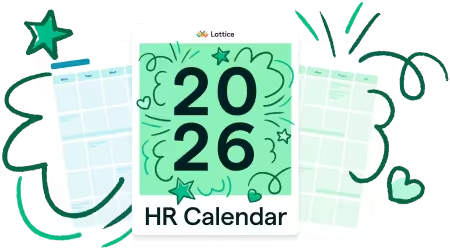Employee Confidentiality Policy Template


Download this template for free
By submitting your information, you agree to Lattice's Terms of Service and Privacy Policy. You can opt out anytime.
Thanks! We'll be in touch soon.
Every company handles sensitive information — whether it’s personal employee data, financial statements, customer records, or proprietary product information. Safeguarding this information isn’t just a matter of good business — it’s a legal and ethical responsibility. That’s why a clearly written and well-communicated Employee Confidentiality Policy is essential.
A Confidentiality Policy outlines how employees should handle sensitive company and client information. It sets expectations, defines what information is considered confidential, and lays out the consequences for mishandling that data. It also helps ensure compliance with privacy laws and builds trust internally and externally.
Use this template to help draft your own Employee Confidentiality Policy or strengthen your existing one. Whether you’re a growing startup or a global enterprise, a strong confidentiality policy can help you protect your people, your partners, and your competitive edge.
What an Employee Confidentiality Policy Should Include
An effective Employee Confidentiality Policy should clearly address:
- What qualifies as confidential information — Include examples such as trade secrets, client lists, pricing structures, internal processes, financial information, or product roadmaps.
- Responsibilities of employees — Explain expectations for protecting information during and after employment.
- Guidelines for communication and data sharing — Cover verbal, written, and digital communications, including social media and public forums.
- Handling of third-party and client data — If your business handles external data, describe how it should be protected.
- Data storage and access — Define how and where confidential information should be stored and who has access.
- Security protocols and tools — Outline any company-issued tools (e.g., password managers, VPNs) that support secure practices.
- Reporting breaches or suspected leaks — Explain what employees should do if they suspect a data breach.
- Consequences of violating the policy — Clearly state disciplinary actions, including termination and potential legal consequences.
Purpose of This Policy
The goal of this Employee Confidentiality Policy is to:
- Protect sensitive company, customer, and employee information from unauthorized access or disclosure.
- Maintain client and stakeholder trust by adhering to privacy and security best practices.
- Educate employees on their roles and responsibilities when handling confidential data.
- Ensure compliance with applicable laws and industry regulations, such as GDPR, HIPAA, or CCPA.
- Reduce the risk of data breaches and the reputational, financial, and legal harm they can cause.
Ultimately, this policy supports a culture of responsibility, accountability, and professionalism — where trust is built through careful handling of information.
Sample Employee Confidentiality Policy
{{rich-highlight-1}}
1. Policy Overview
This Confidentiality Policy outlines [Company Name]’s expectations regarding the handling of confidential and proprietary information. All employees, contractors, interns, and third-party vendors with access to such data are required to comply with this policy as a condition of their engagement with the company.
2. Scope
This policy applies to all individuals who access, process, or manage confidential information during their employment with [Company Name], including but not limited to:
- Full-time and part-time employees
- Temporary or contract workers
- Interns
- Consultants and freelancers
- Vendors and partners with access to sensitive data
3. What Is Considered Confidential Information
Confidential information includes, but is not limited to:
- Business plans, product roadmaps, marketing strategies, and unpublished financial data
- Trade secrets and proprietary research or development
- Customer lists, purchase histories, and personally identifiable information (PII)
- Employee records, including compensation, health data, and disciplinary records
- Internal communications (emails, memos, meeting notes, chat messages)
- Login credentials, system passwords, and security protocols
Information that is publicly available or shared with the explicit permission of the company is not considered confidential.
4. Employee Responsibilities
Employees are expected to:
- Protect confidential data — both in digital and physical formats — from unauthorized access.
- Only share confidential information with coworkers or third parties on a need-to-know basis and only through secure channels.
- Avoid discussing confidential topics in public spaces, on social media, or via unsecured devices.
- Secure their devices and workstations when unattended and use company-approved tools for communication and file storage.
- Adhere to data retention and destruction policies to prevent unauthorized recovery of old files.
These obligations remain in effect even after an employee leaves the company.
{{rich-highlight-3}}
5. Communication and Information Sharing
All communication that involves confidential information must follow company-approved practices:
- Use secure communication platforms (e.g., encrypted email, Slack with MFA).
- Do not share sensitive documents via personal accounts or unapproved cloud services.
- Avoid disclosing confidential data during public speaking engagements, conferences, or media interviews unless pre-approved.
6. Third-Party and Client Data
When handling third-party or client information:
- Treat client data with the same level of confidentiality as internal data.
- Comply with any client-specific confidentiality agreements or data handling procedures.
- Do not reuse or repurpose client data without explicit permission.
7. Data Access and Storage
Confidential data must be stored using secure, company-approved tools and platforms. Only authorized employees should have access to restricted information. Access should be reviewed regularly and revoked upon role changes or offboarding.
Examples of approved practices:
- Use of encrypted cloud storage (e.g., Google Workspace, OneDrive)
- Strong, unique passwords managed through a company-approved password manager
- VPNs for remote access to internal systems
- Regular software updates and endpoint protection software
8. Reporting a Breach
Employees must report any suspected or actual data breach immediately to [HR/contact name] or the [IT/security team]. This includes:
- Unintended disclosure of information (e.g., misdirected email)
- Lost or stolen devices containing sensitive data
- Suspicious activity suggesting unauthorized access
- Malicious software or phishing attempts
Prompt reporting helps contain the incident and prevent further harm.
9. Consequences of Non-Compliance
Violation of this policy may result in disciplinary action, up to and including termination of employment. In cases involving legal or regulatory breaches, the company may pursue legal remedies or notify the appropriate authorities.
Frequently Asked Questions
What if I accidentally shared confidential information?
Mistakes happen. What’s important is that you report the incident immediately to your manager or the IT/security team. Prompt reporting helps minimize potential damage and shows a good-faith effort to correct the error.
Can I take confidential documents home to work on?Only if you’ve received approval and use secure, company-approved tools and systems. Confidential information should never be stored on personal devices or printed and left unsecured.
What happens to this obligation after I leave the company?Confidentiality obligations continue even after your employment ends. You must not share or use any proprietary or sensitive information after leaving [Company Name].
Are NDAs (non-disclosure agreements) still necessary if we have this policy?
Yes. NDAs are legally binding documents that reinforce and supplement the confidentiality obligations described in this policy. Most employees and third parties will be required to sign an NDA as part of onboarding or contracting.
{{rich-highlight-2}}
🚩 Please note: This sample policy is for informational purposes only and does not constitute legal advice. It is a generic template that may not suit your specific circumstances. When adopting or revising a policy, consult legal counsel to ensure compliance with all applicable laws and regulations.
✨ Disclaimer: This resource was developed with the help of artificial intelligence, though reviewed, edited, and approved by (real) humans.
Frequently Asked Questions

Your people are your business
Ensure both are successful with Lattice.





.webp)